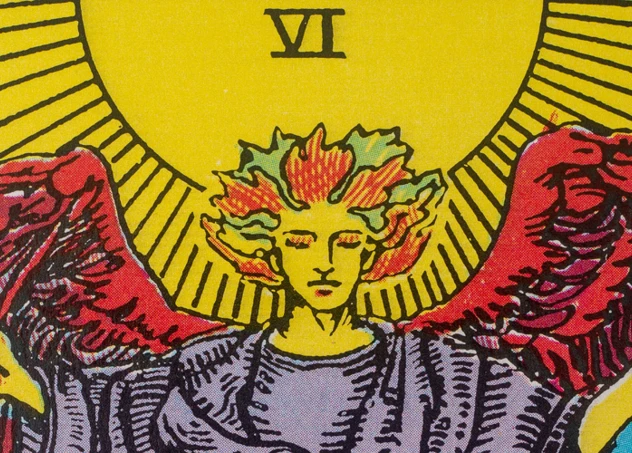Tarot cards have long been associated with mystery and divination, captivating both believers and skeptics alike. However, the influence of tarot goes far beyond spiritual practices, extending to various aspects of Renaissance art and culture. From the rich symbolism depicted in artworks to the fascination of renowned artists such as Leonardo da Vinci, the impact of tarot during this period was profound. Not only did tarot cards serve as sources of inspiration for artists, but they also found their way into the entertainment and courtly culture of Renaissance society. This article delves into the intricate connection between tarot and Renaissance art, exploring the origins of tarot, symbolism in artworks, the involvement of influential artists, and the lasting legacy of tarot on Renaissance culture as a whole.
Contents
- The Origins of Tarot
- Tarot Symbolism in Renaissance Art
- Renaissance Artists and Tarot
- Renaissance Society and Tarot
- Legacy of Tarot in Renaissance Culture
- Conclusion
-
Frequently Asked Questions
- 1. How did tarot cards evolve from playing cards to divination tools?
- 2. What symbolism is commonly found in tarot cards?
- 3. How did tarot influence Renaissance art?
- 4. Were tarot cards exclusively used by the aristocracy during the Renaissance?
- 5. How did Leonardo da Vinci express his fascination with tarot?
- 6. Can tarot cards be considered religious objects?
- 7. How did tarot influence occult practices during the Renaissance?
- 8. Which literary works from the Renaissance incorporate tarot?
- 9. How has the perception of tarot cards changed since the Renaissance?
- 10. What is the significance of tarot in contemporary culture?
- References
The Origins of Tarot
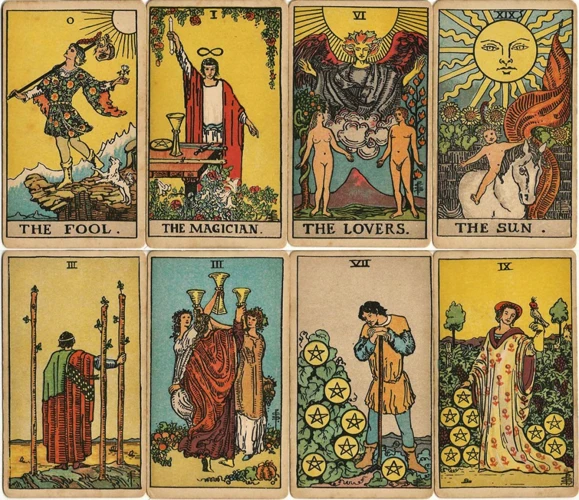
The origins of tarot cards can be traced back to the early 15th century, but their exact origin remains shrouded in mystery. One popular theory suggests that tarot cards were derived from playing cards brought to Europe from the Islamic Mamluk Empire. These cards, known as Mamluk cards, featured intricate designs and symbols that may have inspired the development of tarot. Another theory suggests that tarot originated in ancient Egypt, with the cards representing the journey of the soul through life. Regardless of their precise origin, tarot cards began to gain popularity in Europe, particularly in Italy, during the Renaissance. The earliest known tarot decks, such as the Visconti-Sforza deck, showcased exquisite artwork, often commissioned by the aristocracy. Each card in the deck had its own symbolic meaning, reflecting various aspects of life, spirituality, and human experience. Over time, different versions of the tarot deck emerged, with varying designs and symbols. The evolution of tarot designs and symbols is a fascinating topic on its own, highlighting the dynamic nature of these cards throughout history (/evolution-tarot-designs-symbols/). Tarot cards initially served as playing cards for games, but their deep symbolism eventually led to their use in divination and spiritual practices, which continues to this day (/impact-tarot-modern-divination/). The origins of tarot are deeply intertwined with the cultural and historical context of the Renaissance, making them a significant aspect of Renaissance art and culture.
Tarot Symbolism in Renaissance Art
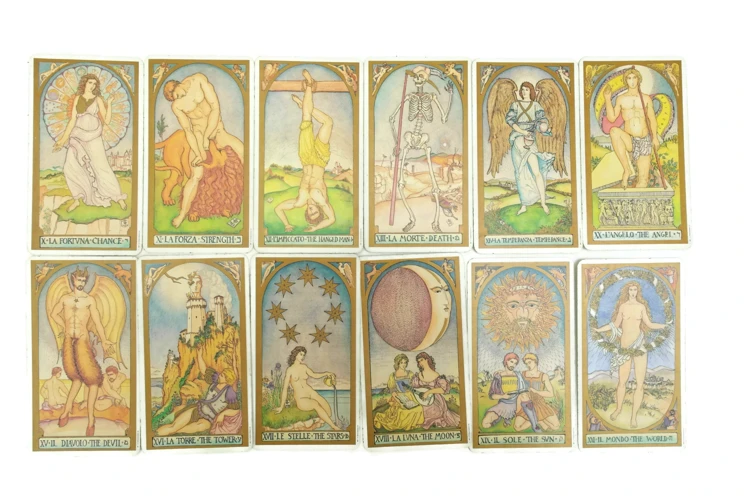
Tarot symbolism played a significant role in Renaissance art, with artists drawing inspiration from the rich imagery and allegorical meanings associated with the tarot cards. The tarot cards served as a source of symbolism that artists incorporated into their artworks, adding depth and hidden meanings to their compositions. Artists often utilized the Major Arcana, the 22 trump cards of the tarot deck, to convey profound concepts and explore themes relevant to the human experience. These symbolic representations found their way into various forms of Renaissance art, including paintings, sculptures, and tapestries. One prominent example of tarot symbolism in Renaissance art is the portrayal of the Fool card, which symbolizes the transformative journey of the soul. Artists skillfully integrated the Fool’s attributes, like the knapsack and the white rose of purity, into their works to convey profound messages about human existence and spiritual growth. The use of tarot symbolism in Renaissance art further emphasizes the interconnectedness of art, spirituality, and the human condition, showcasing the enduring influence of the tarot on artistic expression during this period (/the-origins-and-early-development-of-tarot-cards/).
1. Tarot as a Source of Symbolism
Tarot cards have long been recognized as a rich source of symbolism, providing artists during the Renaissance with a vast array of visual elements to incorporate into their works. The intricate imagery found on tarot cards, such as the Fool, the Magician, or the High Priestess, carried deep symbolic meanings that resonated with the human experience. Artists drew inspiration from these archetypal figures and incorporated them into their paintings, sculptures, and other artistic creations. The symbolic language of the tarot allowed artists to convey complex themes and ideas in a visual and accessible manner. For example, the Fool card, representing new beginnings and taking risks, might be depicted in a painting to convey the theme of transformation or the pursuit of knowledge. The High Priestess, symbolizing intuition and the subconscious, could be incorporated into religious artworks to represent spiritual enlightenment and divine wisdom. Through their use of tarot symbolism, Renaissance artists were able to tap into universal themes and create artworks that resonated with viewers on a profound level. The influence of tarot as a source of symbolism can be seen in countless artworks across various mediums, showcasing the enduring impact of these cards on Renaissance art and culture.
2. The Major Arcana in Artworks
The Major Arcana, a central component of tarot cards, played a significant role in inspiring Renaissance artworks. Artists of the time were drawn to the deep symbolism and allegorical nature of the Major Arcana, which consists of 22 cards representing various archetypes and stages of life. These cards, depicted in vibrant and detailed illustrations, became a rich source of inspiration for artists seeking to convey complex narratives and explore profound themes. The Fool, representing the protagonist’s journey, often appeared in artworks, symbolizing innocence, risk-taking, and new beginnings. The High Priestess, with her mystical knowledge, was a popular subject, embodying wisdom and intuition. The Emperor and Empress cards, symbolizing power and fertility respectively, also found their way into artistic depictions, especially in portraits of royalty and nobility. The Judgment card, representing awakening and transformation, inspired powerful religious paintings and allegorical compositions. Artists skillfully incorporated the imagery and symbolism of the Major Arcana into their works, adding depth and layers of meaning. The intricacies of these tarot cards provided a visual language for artists to communicate complex ideas and emotions, making them an integral part of Renaissance artworks.
3. Tarot in Religious Paintings
Tarot symbolism found its way into religious paintings during the Renaissance, adding layers of meaning and conceptual depth. In these artworks, the Tarot cards were often depicted subtly, integrated into the overall composition. One prominent example is the painting “The Annunciation” by Sandro Botticelli. This masterpiece portrays the angel Gabriel announcing to the Virgin Mary that she will conceive the child Jesus. In this painting, the artist incorporates the imagery of the Tarot card “The Fool,” symbolizing new beginnings and leaps of faith. The Fool is represented by a young, innocent figure wearing colorful attire and standing near a precipice. Botticelli conveys the idea of Mary’s openness to divine intervention and the unknown by incorporating the symbolism of “The Fool” into the scene. Another example is the painting “The Last Supper” by Leonardo da Vinci, where the composition and positioning of the figures align with the symbolism of the Tarot card “The Lovers.” This card represents choices, partnerships, and the harmony of opposites. Leonardo strategically places Jesus in the center, flanked by his twelve followers, creating a visual representation of the card’s symbolism. The presence of Tarot symbolism in religious paintings during the Renaissance reveals the artists’ use of allegory and hidden meanings to enhance the narrative and provoke contemplation among viewers. It demonstrates how the tarot became a source of inspiration and a tool for artists to convey spiritual and philosophical ideas within religious contexts.
Renaissance Artists and Tarot
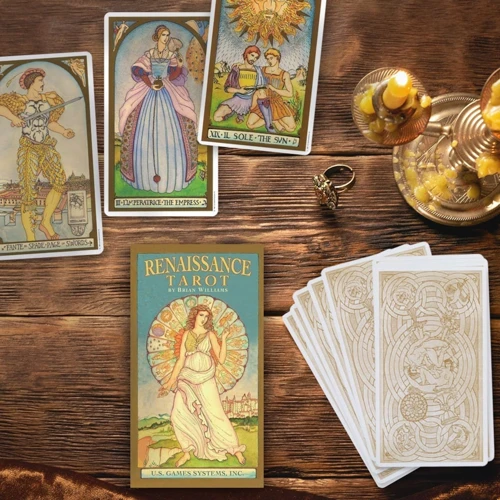
Renaissance artists were not only skilled in capturing the beauty of the world around them, but they also found inspiration in the mystical and symbolic realm of tarot. One of the most prominent figures with a fascination for tarot was Leonardo da Vinci. Known for his insatiable curiosity, da Vinci delved into various esoteric subjects, including tarot. While there is no concrete evidence of his direct involvement with tarot cards, his notebooks contain sketches and references to esoteric symbols that bear resemblance to tarot imagery. Another artist who incorporated tarot symbolism into his works was Hieronymus Bosch. His mysterious and fantastical paintings often depicted enigmatic creatures and symbolic elements reminiscent of tarot cards. Albrecht Dürer, on the other hand, created a series of engravings that were strongly influenced by tarot, known as the Four Horsemen of the Apocalypse. These prints portrayed the archetypal figures of Death, Famine, War, and Plague, representing the concepts found in the tarot’s Major Arcana. The interest and incorporation of tarot symbolism by Renaissance artists demonstrate the wide-ranging influence of tarot on the art and culture of the time, infusing their works with mystery and intrigue.
1. Leonardo da Vinci’s Fascination
Leonardo da Vinci, the legendary Renaissance artist and inventor, was deeply fascinated by various esoteric and mystical subjects, including tarot. While da Vinci is primarily known for his iconic paintings such as the Mona Lisa and The Last Supper, his fascination with tarot is less widely recognized. However, his notebooks provide glimpses into his interest in tarot symbolism and its significance. In his extensive writings, da Vinci explored the connection between the human psyche and the archetypal images found in tarot cards. He believed that these symbols held profound wisdom and could serve as a tool for self-reflection and understanding. Da Vinci’s exploration of tarot was a testament to his insatiable curiosity and his desire to uncover the mysteries of the universe. Though he did not create any known tarot artworks himself, his fascination with tarot undoubtedly influenced his artistic and intellectual pursuits. Da Vinci’s interest in tarot speaks to the broader cultural fascination with the occult and the spiritual during the Renaissance, a time when artists and intellectuals were seeking to unravel the secrets of the universe through various esoteric practices. Leonardo da Vinci’s fascination with tarot serves as a testament to his multifaceted genius and his relentless pursuit of knowledge.
2. Hieronymus Bosch’s Mysterious Works
Hieronymus Bosch, a renowned Dutch painter from the late 15th and early 16th centuries, is known for his enigmatic and often surreal artworks. His works are filled with symbolic imagery and fantastical creatures, creating a sense of mystery and intrigue. When examining Bosch’s paintings, it is evident that he drew inspiration from various sources, including religious texts, folklore, and perhaps even tarot symbolism. One of his most famous works, “The Garden of Earthly Delights,” is a triptych that depicts a vivid and bizarre landscape. In this masterpiece, Bosch presents a fantastical interpretation of the consequences of earthly indulgence and sinful behavior. The intricate details and symbolic elements in the painting have led scholars to interpret it as a reflection of moral and religious themes. While it is unclear whether Bosch directly incorporated tarot symbolism in his works, there are striking similarities between the symbolic language of tarot cards and the motifs present in his art. Both utilize vivid imagery to convey complex meanings and evoke a sense of mystery. Bosch’s fascination with the macabre and the supernatural aligns with the themes often associated with tarot, such as the exploration of the human psyche and the search for spiritual enlightenment. Hence, although the direct influence of tarot on Hieronymus Bosch’s works cannot be confirmed, his mysterious paintings echo the enigmatic nature of tarot symbolism and contribute to the mystical atmosphere of Renaissance art.
Albrecht Dürer, one of the most renowned artists of the Northern Renaissance, had a significant interest in tarot, which is evident in his tarot-related engravings. Dürer’s engravings, known as the “Tarocchi” series, consisted of a deck of cards inspired by the popular tarot decks of his time. Although these engravings were not intended for divination purposes, they featured intricate and symbolic imagery that aligned with the themes and meanings associated with tarot cards. Each card in Dürer’s Tarocchi series depicted a different scene or figure, conveying its own unique symbolism and narrative. For example, his engraving “The Fool” portrayed a jester-like figure, symbolizing the unpredictable and irrational aspects of life. Similarly, “The Tower” depicted a crumbling tower struck by lightning, representing sudden upheaval and destruction. Dürer’s tarot-related engravings not only showcased his artistic skill but also reflected his fascination with the symbolism and themes encompassed in tarot. These engravings added to the growing influence of tarot on Renaissance art and highlight the widespread interest in tarot during this time.
Renaissance Society and Tarot
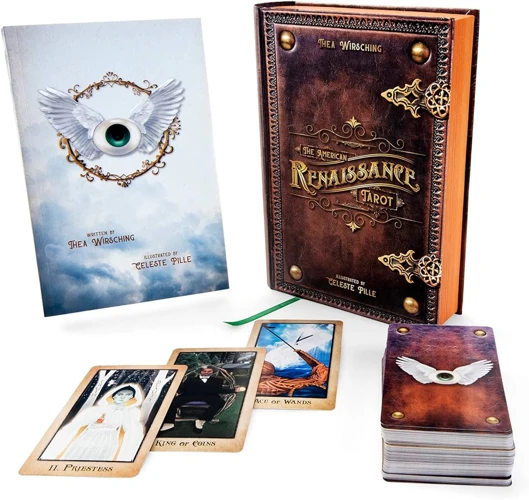
Renaissance society embraced tarot cards not only for their artistic value but also as a source of entertainment and cultural significance. Tarot cards were widely used as a game and a form of amusement among different social classes. Playing tarot games provided a means of socializing, strategizing, and enjoying leisure time. The popularity of tarot extended to the nobility, who often commissioned elaborate, customized tarot decks as a symbol of status and wealth. Tarot became ingrained in the courtly culture of the Renaissance, with its imagery and symbolism present in literature, poetry, and even rituals. The use of tarot cards in literary works, such as the writings of Francesco Petrarca and Matteo Maria Boiardo, showcased the influence of tarot on Renaissance literature. Tarot was intricately connected to the courtly culture of chivalry and romance, with its archetypes and symbols often being referenced in courtly love poetry and romances. Tarot’s impact on Renaissance society went beyond mere divination; it became a part of the cultural fabric of the time, permeating various aspects of everyday life.
1. Tarot as a Game and Entertainment
Tarot cards not only served as a source of symbolism in Renaissance art but also played a significant role in the realm of games and entertainment. During the Renaissance period, tarot decks were commonly used for various card games. The structure of the tarot deck, consisting of four suits (Wands, Cups, Swords, and Pentacles) and the Major Arcana, provided a unique and intriguing gaming experience. The gameplay varied depending on the region, but one popular game was known as “tarocchi,” which involved trick-taking and strategic card play. Tarot cards were also utilized in a game called “tarocchino,” a smaller version of tarocchi played with a reduced deck. The game of tarocchino gained popularity among the nobility and the upper class, showcasing the social aspect of tarot as a form of entertainment. The intricate artwork and symbolism on the cards added an element of mystique and intrigue to the gameplay. Tarot as a game and entertainment not only allowed people to engage in friendly competition but also served as a platform for socializing and displaying one’s wealth and status. The popularity of tarot as a game during the Renaissance highlights its significance in the cultural fabric of the time, showcasing the multifaceted nature of tarot beyond its spiritual and symbolic properties.
2. Tarot and the Nobility
Tarot cards held a special fascination for the nobility during the Renaissance. As symbols of wealth and status, owning a luxurious, intricately designed tarot deck became a sign of prestige among the aristocracy. The nobility would often commission personalized, highly ornate tarot decks, featuring elaborate gold-leaf embellishments and intricate artwork. These decks served not only as tools for divination but also as status symbols and collectors’ items. Some noble families even had their own family coat of arms incorporated into the design of the cards. Tarot cards were not only seen as objects of beauty but were also used as a form of entertainment among the nobility. Card games that utilized tarot decks were popular during social gatherings and courtly events. These games required strategic thinking and provided an opportunity for the aristocracy to display their intelligence and wit. As the nobles indulged in these games, tarot became an integral part of their leisure activities and afternoon soirees. The close association between tarot and the nobility during the Renaissance further elevated the cultural significance and allure of tarot cards in this era.
3. Tarot in Literature and Courtly Culture
Tarot cards not only found their place in visual artworks but also influenced literature and courtly culture during the Renaissance. The rich symbolism and intriguing narratives associated with tarot captivated the imaginations of writers and poets of the time. Tarot imagery began to appear in literary works, providing inspiration for themes, characters, and plotlines. Authors often used tarot cards as tools for foreshadowing events or symbolically representing the journeys of their protagonists. The tarot deck’s archetypal figures, such as the Fool, the Magician, and the Lovers, became enigmatic symbols in literature, adding depth and complexity to the stories. In courtly culture, tarot decks were popular among the nobility, who were drawn to their beauty and symbolism. They were not only used for divination but also as a form of entertainment in grand gatherings and social events. Tarot games, known as tarocchi, were played by the aristocracy, reinforcing the association between tarot and the elite of Renaissance society. These games often required players to interpret the cards, further emphasizing the symbolic significance of tarot in courtly circles. The fascination with tarot in literature and courtly culture during the Renaissance speaks to the enduring influence and allure of these mystical cards beyond their spiritual and artistic realms.
Legacy of Tarot in Renaissance Culture
The legacy of tarot in Renaissance culture extends far beyond its influence on art and entertainment. During this period, tarot began to gain traction as a tool for divination and occult practices. The intricate symbolism and archetypal imagery of tarot cards fascinated those seeking spiritual guidance and insight. Tarot decks were used for fortune-telling, providing glimpses into the past, present, and future. This fascination with tarot extended to other realms of Renaissance culture as well, including literature and theater. Authors and playwrights incorporated tarot imagery and themes into their works, adding an air of mystique and depth. The enduring legacy of tarot in Renaissance culture can still be felt today, as these cards continue to captivate individuals seeking wisdom and self-discovery.
1. Influence on Occult Practices
The tarot’s influence on occult practices during the Renaissance cannot be overstated. As esoteric beliefs gained traction, tarot cards became a powerful tool for divination and spiritual exploration. Tarot decks were seen as gateways to hidden knowledge, offering seekers a means to connect with the divine and gain insights into the future. The symbolism and archetypes depicted in the cards provided a framework for understanding the mysteries of the universe. Occultists, such as the renowned French magician Eliphas Levi, saw tarot as a key to unlocking the secrets of the cosmos, using the cards to delve into the realms of astrology, numerology, and alchemy. The tarot’s influence on occult practices extended beyond divination, permeating practices such as ceremonial magic and ritualistic traditions. The intricate artwork on the cards, coupled with their symbolic depth, evoked a sense of mystical wonder and served as a catalyst for spiritual exploration. The tarot became an indispensable tool for those seeking esoteric knowledge and a connection to the metaphysical realm. Its influence on occult practices during the Renaissance laid the foundation for the continued use and fascination with tarot in mystical and metaphysical circles to this day.
2. Tarot in Literature and Theater
Tarot’s influence during the Renaissance extended beyond visual art and into the realms of literature and theater. The rich symbolism and mystical allure of tarot cards proved to be a captivating source of inspiration for writers and playwrights of the time. In literature, tarot imagery often served as a powerful tool for character development, plot advancement, and foreshadowing. Authors like William Shakespeare incorporated tarot elements into their works, using them to convey deeper meanings and add an air of mystery. One notable example is in Shakespeare’s play “Macbeth,” where the three witches’ prophetic visions are akin to the reading of tarot cards, showcasing the intersection of supernatural forces and human fate. Tarot symbolism became a literary motif that allowed writers to explore themes of destiny, the unknown, and the human psyche. Likewise, in the theater, tarot motifs were often present in Renaissance plays and masquerades. Performances would sometimes include characters dressed as tarot cards, using their symbolic meanings to enhance the narrative and engage the audience. Tarot-inspired costumes and stage design created a visually captivating experience, immersing the viewers in a world of mystery and intrigue. The interplay between tarot, literature, and theater during the Renaissance highlights the widespread fascination with the cards and their enduring impact on artistic expression.
Conclusion
In conclusion, the influence of tarot on Renaissance art and culture cannot be understated. Tarot cards, with their rich symbolism and mysterious allure, served as a profound source of inspiration for artists of the time. Through their intricate designs and intricate meanings, the tarot became a wellspring of ideas, allowing artists to explore themes of spirituality, human experience, and the eternal quest for knowledge and enlightenment. Renowned artists like Leonardo da Vinci, Hieronymus Bosch, and Albrecht Dürer all found themselves intrigued by the enigmatic nature of tarot, incorporating its imagery and concepts into their works. Renaissance society also embraced tarot, both as a form of entertainment and as a reflection of the cultural and social values of the time. The influence of tarot extended beyond the art world, permeating literature, theater, and even occult practices. Its impact on Renaissance culture was far-reaching and continues to resonate in our modern world. The connection between tarot and the Renaissance serves as a testament to the enduring power of symbolism, mysticism, and the enduring fascination of the human spirit.
Frequently Asked Questions
1. How did tarot cards evolve from playing cards to divination tools?
Tarot cards evolved from playing cards to divination tools through the exploration of their symbolic meanings. As people became intrigued by the intricate designs and symbols on the cards, they began to interpret them beyond their traditional use in games. This led to the development of tarot as a tool for divination, where each card held deeper insights into various aspects of life, spirituality, and human experience.
2. What symbolism is commonly found in tarot cards?
Tarot cards feature a wide range of symbolism, with each card carrying its own unique meaning. Common symbols in tarot include elements from nature (such as water, fire, earth, and air), celestial bodies (such as the sun and moon), astrological symbols (such as the zodiac signs), and archetypal figures (such as the Fool, the Magician, and the High Priestess). These symbols collectively form a rich tapestry of meanings that readers use to interpret the cards.
3. How did tarot influence Renaissance art?
Tarot influenced Renaissance art through its symbolism and artistic inspiration. Artists drew upon the imagery and themes found in tarot cards to create meaningful and allegorical works of art. The rich symbolism of tarot provided artists with a language to convey complex ideas and emotions, resulting in artworks that resonate with deeper meanings and layers of interpretation.
4. Were tarot cards exclusively used by the aristocracy during the Renaissance?
No, tarot cards were not exclusively used by the aristocracy during the Renaissance. While some tarot decks were commissioned by the nobility and featured lavish artwork, tarot also became popular among commoners and was used in various social contexts. The accessibility of tarot cards expanded over time, allowing a wider range of individuals to engage with them for both entertainment and divination purposes.
5. How did Leonardo da Vinci express his fascination with tarot?
Leonardo da Vinci expressed his fascination with tarot through his notebooks, where he extensively studied and sketched various symbolic systems, including tarot. His notes indicate a deep interest in the esoteric aspects of tarot, as well as its connection to mathematics, astronomy, and human psychology. Although there is no evidence that da Vinci created his own tarot deck, his exploration of its symbolism showcases his curiosity about the mysteries of life and the human mind.
6. Can tarot cards be considered religious objects?
Tarot cards themselves are not inherently religious objects. However, throughout history, various religious and spiritual groups have incorporated tarot into their practices, often infusing the cards with their own belief systems and interpretations. Consequently, the way tarot is used and perceived can vary, with some viewing it as a tool for spiritual guidance, while others approach it purely as a psychological or artistic tool.
7. How did tarot influence occult practices during the Renaissance?
Tarot had a significant influence on occult practices during the Renaissance. The symbolism within tarot cards, with its esoteric and mystical connotations, aligned with the interests of occultists seeking hidden knowledge and spiritual enlightenment. Tarot was integrated into various occult systems, such as Hermeticism and alchemy, and became an important tool for divination and spiritual exploration in those circles.
8. Which literary works from the Renaissance incorporate tarot?
Several literary works from the Renaissance incorporate tarot, often using the cards as symbols and metaphors to explore themes of fate, fortune, and human nature. One notable example is “The Divine Comedy” by Dante Alighieri, where tarot symbolism is woven throughout the journey of the protagonist. Other works, such as “The Hanged Man” by Robert Walser and “The Castle of Crossed Destinies” by Italo Calvino, also feature tarot-inspired narratives.
9. How has the perception of tarot cards changed since the Renaissance?
The perception of tarot cards has evolved over time. In the Renaissance, tarot was primarily seen as a tool for entertainment and symbolism in art. However, as interest in the occult and divination grew during the 19th and 20th centuries, tarot became more commonly associated with spiritual practices and fortune-telling. In modern times, tarot has gained widespread acceptance as a tool for personal growth, introspection, and guidance, with many seeing it as a valuable psychological tool for self-reflection.
10. What is the significance of tarot in contemporary culture?
Tarot continues to have a significant presence in contemporary culture. Beyond its use in divination and personal exploration, tarot has also influenced various artistic mediums, such as literature, film, and visual arts. It has become a symbol of creativity, mystery, and self-discovery, resonating with individuals seeking guidance and seeking to explore the depths of the human experience. Tarot’s enduring legacy in contemporary culture is a testament to its timeless appeal and enduring relevance.
